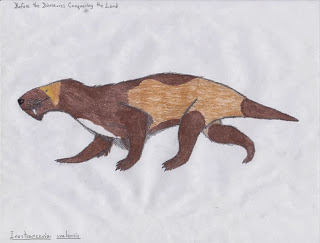Acrophoca lonairostris
Our first creature, is Acrophoca. I never even knew this animal existed until about two months ago. Acrophoca is an ancestor to the modern day leopard seal, but unlike leopard seals, they lived in the waters around Peru or Argentina, have claws on their flippers, and ate fish, instead of penguins. They lack the canines that grip and tear up penguins, but have the teeth for noming on fish. Overall, the restoration above it similar to the only skeletal of this animal, and gives it brown fur, unlike the few restorations that have leopard seal patterning. Overall, a unique and beautiful Pliocene pinniped.
Arctotherium augistidens
We are now moving on to the pinnipeds closest living relative, bears. Above is one of the very few reconstructions of a contender for the largest carnivorous land mammal on Earth. Arctotherium, the South American Short Faced Bear. The short faced bears are all but extinct today, the only relative being the speckled bear in South America. Bears are not native to South America, but around the start of the Pleistocene, a land bridge formed, allowing animals from North and South America to invade either area. One of the North American migrants where the short faced bears.
Above, you are looking at Arctotherium. It is thought to be weighing close to a tonne, and be 3 meters long. This alone makes it bigger than Arctodus, its North American cousin. Why it got so big is still a mystery, but the restoration above is on the few (sadly) of this animal, and really shows just how robust they were.
Dinofelis pivetaui
When thinking about Cenozoic carnivorous mammals, you just can't forget one very deadly one. The Machairodonts, or the sabre-toothed cats. The most famous is Smilodon fatalis, from North America of the Pleistocene, but many are left in the dark and often not known. Another moderately well known Machairodont is Dinofelis, which got its popularity thanks the the fantastic Walking with Beasts. However, in most restorations, this cat is depicted robust, like in WWB, and also a similar pattern. This type of art is very common in the paleoart community, and it wasn't until All Yesterdays that we managed to finally think outside the box. Above, I would categorize this as All Yesterdays. Instead of the robust WWB Dinofelis we all know, we have a cheetah like Dinofelis. While I think Dinofelis was not as fast as a cheetha, it was certainly deadlier. With its small but incredibly dangerous sabre-teeth, there is no way an early hominid could survive a bite to the head, from this predator.
Ichthyovenator laosensis
We recently learned of the discovery of Ichthyovenator, the most appropriately named spinosaur to date, and its bizarre sail. I will say one thing. I think a skin membrane or a fat storing area would fill the gap between the sails, but this is speculation and has nothing to do with the illustration above. The pose and basic build of the animal is based off of Scott Hartmans Suchomimus skeletal, and it is possible that Ichthyovenator was closely related to Suchomimus. However, this animal is restored in a way that I haven't seen before. It isn't shrink wrapped! The animal actually looks like something that can swim and catch prey with his arms, and use its tail to help swim through the swamps of Cretaceous Laos, and this should be depicted more often.
I don't need to explain
Recently, we learned about HIS existence, but I won't rehash that. Instead, I'll talk about a unique way the artist depicted him above. I learned that the artist was trying to portray Lythronax as a scavenger. In my blog post, I stated that someone was not to far off saying that it was a scavenger. However, I don't find it infuriating. I find this theory intresting, and it is possible that Lythronax was part of a group of tyrannosaurs that scavenged, rather than hunting.
Inostrancevia uralensis
I love this restoration. I am in deep love with it. When we see Inostrancevia, we also see the most well known species, I. alexandri. Instead, we have I. uralensis. I haven't seen another restoration of this species ( may have missed something) and it's good to see it instead of another I. alexandri. It is also good to see a rare restoration of a rarely depicted Inostrancevia species in a rare way. The colours are based off of wolverines, and it has fur all over its body. This shows the reptiles relationship to mammals. It has long fur on its belly and arms, something I've never seen before. It also has whiskers, something rarely depicted too, and it even has a mammal like nose. It may be that gorgonopsids where not covered in fur, but maybe they where. I speculate that while they lay eggs, they may have suckled their young. However, that is my theory, and has nothing to do with the rare restoration of a rare species of Inostrancevia.
Xenosmilus hodsonae
I will end my longest blog post on another rarely depicted Machairodont, Xenosmilus. It has the look of a tiger, but more robust, with a shorter tail, and longer canines. I should also note that while the artist was making it, he let people suggest what pattern and colour it should be. I suggested the golden tiger (a very rare breed of tiger) and he went with it.
I have to thank Yutyrannus from the Dinosaur Toy Forum for letting me use his artwork as I ramble on about the fantastically obscure species he chose to restorate. Until next time, have a great day!







No comments:
Post a Comment